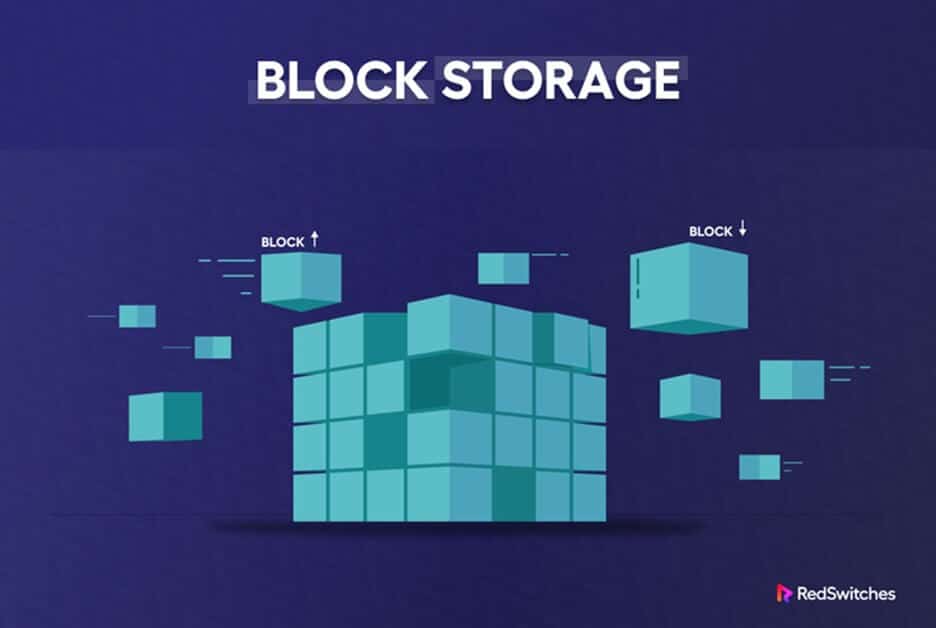Understanding the most suitable storage type for your business is essential. What do you consider in your choice for storage? You look out for capacity, speed, efficiency, and security, and your choice of storage should protect your data from threats and environmental hazards. Whether you are a small, medium, or multinational company, your choice depends on these factors.
Storage services store all your company’s data in a cloud computing environment. Your storage service should be large enough to keep user or application information. Also, your storage should be accessible on the go. Cloud computing allows users to access information from anywhere worldwide, provided that they connect via the internet. In this same light, the storage for any computing environment should be accessible 24/7.
Out of the several storage types, block storage will be our key focus in this article. We will show you the details about Block storage in cloud computing. So, if you are looking for a good storage option, read on to know more about data storage with block storage.
Table of Content
- What Is Block Storage?
- How Does It Work?
- What Are The Use Cases Of Block Storage?
- Difference Between Block Storage vs. File Storage vs. Object Storage
- Block Storage: Pros and Cons
- Why Block Storage
- Key Takeaways
- FAQs
What Is Block Storage?
As the name implies, block storage stores data by dividing them into fixed-sized data pieces called blocks. The storage administrator-storage area networks( SANs) manage operations in block storage.
This storage is a popular choice among developers. Here’s why: speed, efficiency, data storage, and retrieval reliability. How, then, does cloud block data storage work?
How Does It Work?
As mentioned, block storage stores data in blocks instead of files or folders. There is a separate software that controls what happens in block storage. Each block has a unique address for ease of identification when needed. This way, you can easily retrieve and compile data into files by simply locating the address.
Then, there is also a data lookup table that stores each address in a way that makes it easy to retrieve. Block storage lacks a metadata kind of storage, which has folders, ownership, and timestamp. So, in the case of retrieval, the software in charge looks up the data lookup table. It spreads the requested data over multiple blocks and recalls it using the unique identifier. After retrieval, the software merges the spread-out blocks to their original form for safety.
Link: iStock Photo
What Are The Use Cases Of Block Storage?
Block storage is preferred for various reasons, including data-intensive workloads and efficiency. You will find the different types of block storage in containers, time series databases, email servers, transactional databases, virtual machines, and hypervisor file systems.
Difference Between Block Storage vs. File Storage vs. Object Storage
Aside from block storage, service providers use other storage types, including object and file storage. How does block storage differ from the others?
Object Storage
Object storage stores and manages data in unstructured units as objects. Photos, email, audio files, videos, web pages, and sensor data are unstructured data types. Although the arrangement is unstructured, object storage contains metadata that describes each object.
Block Storage vs. Object Storage
Block storage and object storage are similar in providing low latency and high-performance levels. While block storage allows you to edit a part of data, object storage does not. Instead, object storage requires you to edit the entire file to make changes.
Block storage is usually costlier compared to object storage. Object storage is less expensive and does not limit the amount of metadata. It has a better performance in terms of scalability and customization. Organizations like Facebook and Amazon use object storage for large media and user volume.
File Storage
File storage uses files and folders to store data. This storage type differs from block and object as it keeps data in a hierarchical format. When you store data in this format, you can access your files like you assess a local hard drive. Best of all, file storage is user-friendly. It allows you and your clients to share and manage files.
Block Storage Vs. File Storage
Block storage allows you to upload new data blocks to the existing system without increasing operational latency. The flexibility of block storage gives a higher performance which is rare with file storage systems.
However, a file is more convenient for a user during data retrieval. With file storage, you locate data using information like the filename, directory, or URL. In contrast, block storage uses data blocks to find a missing address.
Link: iStock Photo
Block Storage: Pros and Cons
Block storage is popular due to its many benefits, as shown in the table below.
|
Advantages of Block Storage |
|
| High Performance | It’s high efficiency and low latency make it the best option for activities that deal with large data volumes, i.e., database servers. |
| Flexibility | Block storage allows flexible horizontal scaling. As the storage needs of your business grow, you can increase block storage volumes without a lag in performance. |
| Fast Data Storage and Retrieval | The absence of folders and hierarchies quickens the input and output of data in block storage. With the unique identifiers, you can retrieve data quickly. |
| Ease of File Modification | You can edit a part of a file in block storage without changing the entire file. But with other types, a change to a part signifies a change to the entire object. |
| Compatibility | You can access block storage from different operating systems. This makes it compatible with your kind of business, no matter the model. |
Block storage also has some drawbacks despite its many benefits.
More significant Cost: Although block storage supports scale-ups, it can be expensive. The high cost is due to the cost of the software for administration, training, and maintenance that block storage requires.
Metadata limitations: Limited metadata may reduce performance. As a result of limited metadata, applications need help identifying requested data using easy terms. Instead, it has to search through several blocks to locate data.
Block Storage Examples
The simplest block storage example is the virtualization vendor VMware. Organizations that use a large volume of data, such as Microsoft Exchange, Oracle, Amazon EBS (Elastic Block Store), and Spotify, utilize block storage.
Why Block Storage?
As an organization, your needs vary from time to time. You need a storage type that would accommodate increasing workloads. High efficiency, scalability, and speed remain the top needs that block storage satisfies. If top companies like Dell and Amazon opt for block storage, you could too.
Key Takeaways
Block storage is one type that you will find very helpful in storing your company’s data. This article has provided answers to questions like what is block storage in the cloud and more. Remember these key points.
- Block storage is a storage type that stores data in fixed-sized data pieces called blocks.
- The Storage Area Network-SAN gives each block a unique address for easy data input and retrieval.
- Block storage has many benefits, including scalability, efficiency, high performance, speed, and flexibility.
- Block storage is useful in data-intensive workloads, transactional workloads, containers, email, and Virtualization.
- Block storage has the advantage of compatibility regardless of your business model or size.
- Planning requires choosing the most suitable storage type for your company as your needs increase.
Now that you know what is block storage, what cloud block storage should you get for your company? Redswitches’ Block Storage has the benefits above, plus reliability and security. Check us out today by reaching out; we are ready to answer any more questions.
Frequently Asked Questions
1. How does block storage differ from other cloud storage types?
Block storage differs from other types of cloud storage, like file storage and object storage, in how data is stored, accessed, and handled.
2. What is the maximum size of a block storage volume in the cloud?
SSD volumes in Cloud Block Storage must be at least 50 GB in size, whereas SATA volumes must be at least 75 GB. One Terabyte (1 TB) is the maximum volume size.
3. Can I migrate block storage volumes between different cloud providers?
Yes, this is called cloud-to-cloud migration and usually requires competent experts.
4. What are the key benefits of using block storage in cloud computing?
Using block storage in cloud computing offers several key benefits, including:
Performance
Block storage allows for high-performance, low-latency data access. It is intended for applications requiring rapid and efficient random read and write operations. This makes it ideal for database, transactional, and I/O-intensive workloads where speed is crucial.
Flexibility
Block storage offers flexibility in terms of capacity and scalability. Cloud providers allow users to provision and allocate block storage volumes of various sizes, and they can quickly scale up or down as needed. This flexibility enables users to meet their changing storage requirements without significant disruption.
Data Integrity and Durability
Block storage systems often include data integrity and redundancy mechanisms. They typically employ data protection methods such as RAID (Redundant Array of Independent Disks) or replication to ensure data durability and availability. This helps prevent data loss and ensures that data remains accessible even during hardware failures.
Snapshot and Backup Capabilities
Block storage typically supports snapshot and backup features, allowing users to create point-in-time copies of their data. Snapshots enable data recovery and system rollbacks, providing additional data protection and easy restoration to a previous state.
5. How does block storage pricing work in the cloud?
Your cloud provider will determine this; you can reach out to Redswitches to get a rough idea of what their block storage infrastructure pricing might be.



